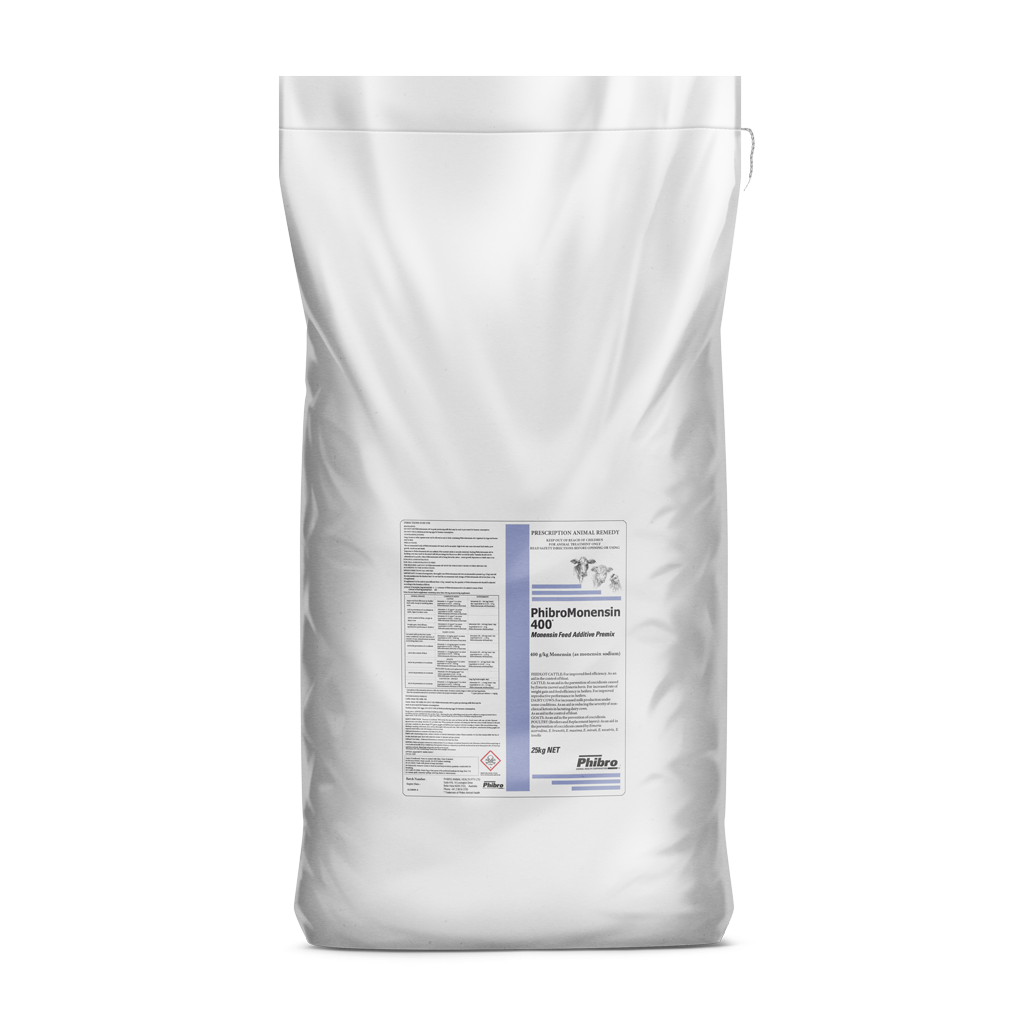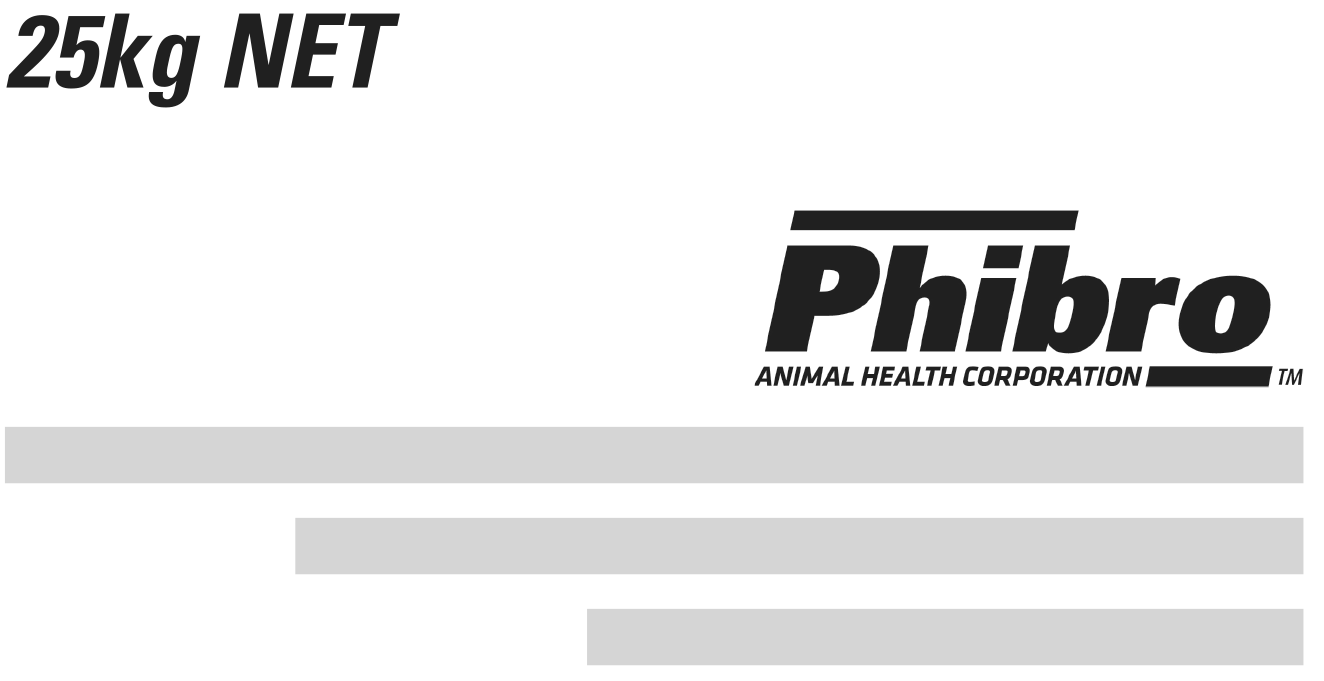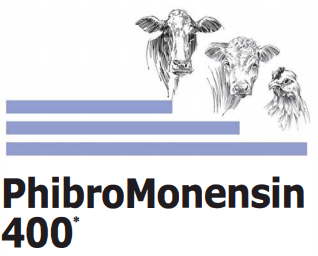PRODUCT DESCRIPTION:
PhibroMonensin 400 is an ionophore compound used for improving the feed efficiency in feedlot cattle (except lactating dairy cows). It is also used to increase milk production in dairy cows under some conditions and to reduce the severity of nonclinical ketosis in lactating dairy cows PhibroMonensin 400 is also used to aid in the prevention of coccidiosis in chickens, cattle and goats.
In feedlot cattle PhibroMonensin 400 alters the ratio of Volatile Fatty Acids produced by rumen fermentation. PhibroMonensin 400 favours the production of propionic acid, which is the most efficient energy source of the VFA’s produced in the rumen. Ionophore compounds also alter the flow of blood through the portal vein, which enhances the absorption of nutrients from the large intestine. This mode of action is responsible for improving the ADG and FCE.
In lactating dairy cows, the alteration in the ratio of VFA’s produced also occurs similarly to that in feedlot cattle. The shift towards the production of propionic acid leads to increased milk production, while the reduced levels of ketone bodies in early lactation cow’s due to a reduction in body fat mobilization, helps to reduce the severity of nonclinical ketosis.
In the production of broiler chickens, coccidia belonging to the genus Eimeria are ingested by chickens and invade the lining of the intestine or caeca. Coccidiosis reduces ADG and FCE, and increases mortality rates. Cattle and goats are also affected by coccidia that damage the lining of the intestine, reduce the ADG and FCE and cause scouring. PhibroMonensin 400 facilitates the movement of ions across cell membranes. The molecule “dissolves” in the cell membrane of the coccidia and acts as a conduit, transporting sodium and/or potassium into the cell. This upsets the cell’s physiological balance and the cell begins absorbing too much water and must expend energy to eliminate excess water. When the “pump” eliminating excess water from the cell depletes the cell’s energy stores and stops, the cell balloons and the parasite dies.
Active Ingredient:
Monensin (as monensin sodium) 400 g/kg

REGISTERED CLAIMS:
To improve feed efficiency in feedlot cattle (except lactating dairy cows). To increase milk production in daily cows under some conditions. As an aid in reducing the severity of nonclinical ketosis in lactating dairy cows. As an aid in the prevention of coccidiosis in chickens (Eimeria acervulina, E. brunetti, E. maxima, E. mivati, E. necatrix, E. tenella), cattle (E. zuernii, E. bovis) and goats (E. arloingi, E. christenseni, E. ninakohlyakimovae).
DIRECTIONS FOR USE:
RESTRAINTS:
DO NOT USE PhibroMonensin in goats producing milk for human consumption.
DO NOT USE in chickens producing eggs for human consumption.
PRECAUTIONS:
DO NOT exceed recommended levels of PhibroMonensin and DO NOT ADMINISTER PhibroMonensin to cattle treated with a monensin-containing anti bloat capsule within the previous 100 days. High levels can cause reduced feed intake, poor growth, disease and death. Responses to PhibroMonensin are unlikely if the nutrient intake is significantly restricted.
DO NOT allow dogs, horses or other equines access to feeds containing PhibroMonensin. Ingestion by dogs and horses may be fatal.
Poultry consuming monensin sodium should not be treated with tiamulin. Severe growth depression or death may occur.
As per Good Industry Practice, colostrum and milk collected within 96 hours (8 milkings) after calving must not be used for human consumption or processing. Feeding monensin to lactating dairy cows may result in decreased milk fat percentage, but there is no effect on total fat yield. PhibroMonensin must be thoroughly mixed with other feed components and care should be taken in transporting mixed feed to prevent settling. It is recommended that appropriate quantity of PhibroMonensin be mixed with 10 kg of ground meal before adding gradually to the feed blend. Rations containing silage or other wet feeds should be corrected to a 90% dry matter basis for calculation of the appropriate monensin dosage.
DOSAGE AND ADMINISTRATION:
| FEEDLOT CATTLE (Improved feed efficiency): | DAIRY CATTLE (To increase milk production in dairy cows under some conditions. As an aid in reducing the severity of nonclinical ketosis in lactating dairy cows): |
CATTLE (To aid in the prevention of coccidiosis in cattle 50 to 150 kg live weight): | GOATS (To aid in the prevention of coccidiosis): | LAYER REPLACEMENT AND BROILER CHICKENS (To aid in the prevention of coccidiosis): |
|---|---|---|---|---|
|
Complete feeds: Thoroughly mix 27.5 to 82.5g PhibroMonensin 400 (to deliver 11 to 33 g monensin) to each tonne of complete feed. Supplements: |
Complete feeds: Thoroughly mix 15 to 45 g PhibroMonensin 400 (to deliver 6 to 18 g monensin) to each tonne of complete feed (90% dry matter basis). Aim to provide 200 to 250 mg monensin per animal per day in the final feed. The monensin feed level decision should be based upon a consideration of the live weight and feed intake of the cows. Supplements: |
Complete feeds: Thoroughly mix 27.5 to 82.5 g PhibroMonensin 400 (to deliver 11 to 33 g monensin) to each tonne of complete feed. Supplements: |
Complete feeds: Thoroughly mix 12.5 to 50 g PhibroMonensin 400 (to deliver 5 to 20 g monensin) to each tonne of complete feed. Supplements: |
Complete feeds: Thoroughly mix 250 to 300 g PhibroMonensin 400 (to deliver 100 to 120 g monensin) to each tonne of complete feed. Care must be taken that the upper limit of 120 g monensin per tonne of feed is not exceeded Feed continuously to broilers as the only ration. Feed continuously to layer replacements until placed in cages. |
SAFETY DIRECTIONS:
Poisonous if swallowed. Will irritate the eyes, nose and throat and skin. Avoid contact with eyes and skin. Repeated exposure may cause allergic disorders. Do not inhale dust. When opening the container and mixing into feed wear cotton overalls buttoned to the neck and wrist, a washable hat, elbow-length PVC gloves, goggles and half face piece respirator with dust cartridge or canister. After use and before eating, drinking or smoking, wash hands, arms and face thoroughly with soap and water. After each day’s use, wash gloves, contaminated clothing, goggles and respirator and if rubber, wash with detergent and warm water.
Toxic if swallowed. Toxic in contact with skin. Toxic if inhaled.
IF SWALLOWED: Rinse mouth. DO NOT induce vomiting.
IF ON SKIN: Wash with plenty of soap and water.
IF INHALED: Remove victim to fresh air and keep at rest in a position comfortable for breathing.
IN CASE OF FIRE: Water fog or fine spray is the preferred medium for large fires. Try to contain spills, minimise spillage entering drains or watercourses.

FIRST AID: If poisoning occurs, contact a doctor or Poisons Information Centre. Phone Australia 131126, New Zealand 0800 764 766. If in eyes, hold eyes open, flood with water for at least 15 minutes and see a doctor.
-
- WITHHOLDING PERIOD
Cattle:
Meat: Nil.
Milk: Nil.
Goats:
Meat: Nil.
Milk: DO NOT USE PhibroMonensin 400 in goats producing milk that may used or processed for human consumption.Poultry:
Meat: Nil.
Eggs: DO NOT USE in birds producing eggs for human consumption. be
- WITHHOLDING PERIOD
- Trade Advise : EXPORT SLAUGHTER INTERVAL (ESI): An ESI has not been established for this product. Note – observing the meat withholding period may not be sufficient to mitigate potential risks to export trade. Trade advice should be sought from Phibro Animal Health Pty Ltd on 02 9616 3750 before using the product.
To Learn More:
The success of your farm operation is directly related to the success of your animals. With Phibro as your partner, you can count on our portfolio of Monensin products to help you achieve the results you want.
Talk with a Phibro team member.
Learn More Contact Us Now!


